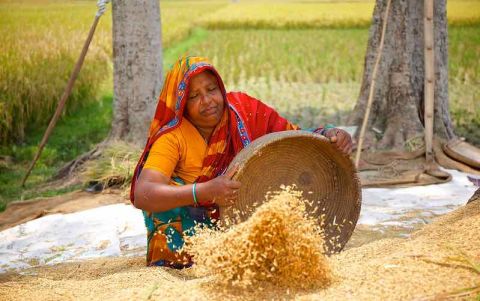
Introduction: In the quest for sustainable agriculture and improved livelihoods for rural farmers, Transforming Agrifood Systems in South Asia (TAFSSA) organized a Farmers Field Day . This enlightening event aimed to gather farmers’ opinions about different crops in the Rabi and Kharif 1 seasons, identify the pros and cons of various crop cultivation methods, and explore the best crop rotation practices. It was held on 31st May 2023 in the picturesque Chargonai village under Kaunia Upazilla, Rangpur district, one of the 8 sites were researches and farmers are joining hands in the implementation of participatory on-farm trials.
Rabi Season: A Bountiful Harvest: The Rabi season is characterized by a plentiful harvest. During the deliberations pertaining to the Rabi season, agricultural practitioners conveyed their satisfaction with the prosperous cultivation of their crops. The early harvesting of Napa Shak was found to have positive effects on their dietary patterns, as well as providing an opportunity for them to generate more revenue by selling their excess product in the nearby market. Kholilur Rahman reported engaging in the cultivation of a significant expanse of leafy vegetables, resulting in considerable economic gains. Nevertheless, the local market experienced an oversupply of Napa Shak, which therefore led to price reductions. As a result, several farmers began to investigate alternate markets. Mojibar Rahman discussed the economic viability of Napa Shak as a profitable alternative to aman rice, citing its reduced manufacturing costs. Additionally, Jorina Begum emphasized her achievements in selling Napa Shak during that particular year.
Carrots: A Nutritional Marvel: An Exemplary Source of Nutrition The majority of farmers expressed enthusiasm in engaging in the cultivation of carrots, a novel crop in the region that exhibited substantial demand due to its advantageous nutritional properties. By engaging in the cultivation of carrots on their land, individuals were able to secure a reliable source of vital vitamins and minerals (e.g. Vitamin A). Abdul Latif conveyed his satisfaction in the introduction of a novel cropping pattern, which has unveiled the prospects of expanding carrot cultivation and marketing it at more lucrative markets to attain increased profits.
Potato: A Thriving Market Crop: The cultivation of potatoes is well established in the region, with a strong market demand. The prevalence of potato cultivation resulted in farmers encountering few obstacles, and external purchasers frequented the region to procure potatoes at their own cost, so incentivizing farmers to persist in cultivating this lucrative commodity.
Kharif 1 Season: Groundnut and Maize Reign Supreme: Farmers acknowledged their contentment with the planting of maize during the Kharif 1 season, owing to its robust market demand. Jobayer Rahman, a farmer, underlined the necessity of utilizing dwarf maize varieties as a means of safeguarding against probable storm-related damages. This concern was also expressed by Md. Mokhlesur Rahman, who underscored the significance of carefully selecting dwarf maize varieties in order to enhance resilience against hailstorms. Groundnut is the most cultivated crop in this area during Kharif 1; whereas demand for the produce is good, prices are relatively low (75 – 85 BDT/kg up to 2-3 months after harvesting).
Challenges and Aspirations: Farmers openly discussed challenges related to market demand and linkage, particularly for carrots. Abdul Hakim, a lead farmer, stressed the need for crop production and preservation training to enhance productivity and improve preservation techniques. Farmers recognized the nutritional benefits of diverse crops but acknowledged the management complexities of cultivating different crops on the same land. Amina Khatun lauded the TAFSSA initiative for transforming their daily lives, shifting their focus from cultivation solely for profit to considering the nutritional impact on their lives.
A Field Visit Full of Promise: The program concluded with an inspiring field visit, where farmers witnessed bumper groundnut production and robust maize fields, despite some damage caused by a recent storm. Farmers eagerly sought short-duration and dwarf maize varieties to protect against future storm damages, with hope instilled by CIMMYT’s collaboration with Bangladesh Agricultural Research Institute (BARI).
Conclusion: The event left a lasting impact on both farmers and CIMMYT, promising a brighter and healthier future for all stakeholders. The valuable knowledge gained from this event will undoubtedly shape more resilient and prosperous agricultural practices, improving the lives of farmers and communities alike.



